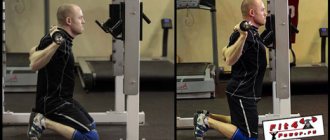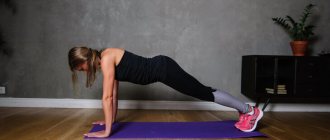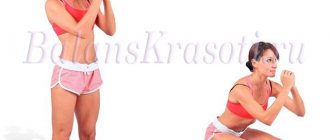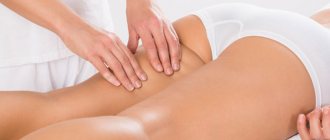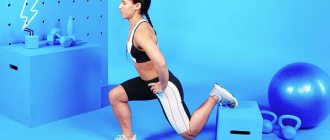Correct squats at home are included in almost any set of physical activities; they are one of the effective basic exercises that give noticeable and quick results. With its help, a beautiful hip line and expressive buttocks are formed, excess fat is removed from the lower body, and a lot of calories are burned. Additionally, performing at a fast pace speeds up the heart rate, which gives a significant cardio load. But how to squat correctly? How to do this exercise at home without a trainer?
The “Health” section is your detailed guide to healthy lifestyle issues. Training, nutrition, amateur sports - we have only the most important and useful information that will help you become better every day. Subscribe to our telegram channel to be the first to receive the latest articles.
Benefits of squats
Squats have a number of important benefits:
- slimness and fit of the lower body;
- stimulation of the production of growth hormone, due to which muscle mass quickly increases and relief is formed;
- strengthens the back muscles;
- posture improves;
- hip joints become flexible;
- lymph and blood flow accelerates;
- acceleration of metabolic processes;
- help strengthen the core and abdominal muscles;
- development of speed and strength.
Doing squats has a positive effect on endurance and develops proper balance and coordination of movements. All positive properties are achieved provided that the exercise is performed correctly. If the squatting technique is violated, the effectiveness significantly decreases.
Will squats help you lose weight?
Squats are undoubtedly suitable for weight loss workouts. The main thing here is to choose the right pace, load mode, number of repetitions and weight.
The benefits of squats for weight loss will be if the duration of the workout itself is at least 40 minutes.
To begin with, the muscles need to be stretched; in the first 20 minutes of training, the body spends glucose (glycogen in the muscles and liver), only then fats begin to be burned. Fats are necessary for energy during training, and if the loads are sufficiently energy-intensive and long-lasting, the body will burn its own fats regardless of what exercise or type of load it performs.
The longer the exercise is performed and the less time is given for rest, the higher the heart rate, which accelerates the metabolism, expends more energy, as a result of which more fat is burned in the body. Despite the fact that squats are aimed at developing the lower body, it is impossible to burn fat locally using the exercise. Therefore, squats contribute to weight loss not only in the legs and hips, but also in the entire body as a whole.
Types of squats
Once you have mastered the technique, you can make the workout more complex or varied in order to work the largest number of muscles in one session. The most common type of squats after the classic one is the plie.
How to squat “plie”: the technique is the same, only the legs are placed wider, and when squatting, the knees are spread to the side. This works the inner thighs.
There are other variations that can help you innovate your workouts while still maintaining their effectiveness.
Squats without weight
First, let's look at exercise options that are performed without additional load. They can be performed by beginners who have fully mastered the classical technique.
On one leg
Squats on one leg train not only muscles very well, but also balance and coordination of movements. In this variation, one leg is brought forward, and the arms are also brought forward to maintain balance. All the weight and load falls on the second leg. The exercise works the muscles twice as well.
The main thing is to learn not to fall to the sides when performing a squat on one leg. This is difficult; it is not easy for beginners and even advanced athletes to do it the first time.
With a jump
Straight squats with a jump and a 90- or 180-degree twist are a good variation for the workout. They are performed from the starting position of the classic exercise.
The difference is that you need to push harder with your toes, jumping up, then return to your heels again, lowering your pelvis. In turns of 180 and 90 degrees, you need to turn clockwise or counterclockwise while jumping.
The advantage of the exercise is that it increases the cardio load and works the upper thigh muscles better. The main thing is to ensure that during intense jumps, your back remains straight and your hips fall parallel to the floor, not lower or higher.
Burpee
Combined with squats, this is an exercise that allows you to work all muscle groups. It includes several elements of different exercises:
- bar;
- rock climber;
- squats.
It is performed from the starting “plank” position. You need to lie on the floor, rest your palms and toes on the floor, raise your body so that your back, pelvis and shoulders are in one straight line.
Then both legs are pulled to the chest, and through a squat you need to take a vertical position.
Then sit down again, rest your hands on the floor, return your legs to their original position.
do squats help you lose weight
It just so happens that legs are the personification of female beauty. And this is not trivial, because you often hear catchphrases such as “feet from the ears”, “oh, what legs” and admire, and sometimes with envy, gaze at beautiful slender legs. But these are someone's legs, not your legs! It doesn’t matter how old you are: 20, 30... 60 - you can also have the same athletic legs, without excess fat deposits. This is not to say that removing fat from the thighs is quite simple, but the most important thing is to want to! You can also remove belly fat and achieve a completely flat stomach! The way the female body is structured is that extra pounds settle mainly on the lower part of the body. And since you are reading this article and wondering how to remove fat from your thighs, then you are already on the path to losing weight. The most important thing is not to stop at the material you read, but to set yourself up for radical changes. If you want a beautiful body, remove fat from your thighs and knees - moderate your appetite, move more! Our legs will not become slender in a week, but every day will bring us closer to this! Eat to live! In order to remove fat from your knees and thighs, there is no need to torture yourself with hunger or adhere to strict diets; it is enough to limit yourself to eating sweets, flour, baked goods, fatty meats, fatty foods in general, and potatoes. By the way, the Chinese use potatoes as a cure for thinness. Watch yourself, very often we eat not because we are hungry, but then to experience the pleasure of food. As a rule, we get this pleasure from pastries, cakes, sweets, cookies, ice cream mainly in the evening - in front of the TV. Therefore, if you want to remove fat from your thighs and knees, give up dinner after six or stick to one of the simple diets. At first, it will be quite difficult, only when you think that you don’t have to eat, you just want to eat something more than anything else. Don’t put too much emphasis on it, set yourself up positively - start gradually denying yourself something. In order to remove fat from your knees and thighs, just drink kefir with a piece of black bread, eat vegetables, fruits, and instead of sweet soda, dilute natural juice with water. Over time, the body will get used to it and it will be quite easy to refuse dinner. Move more! You won’t be able to remove fat from your knees, legs, thighs with just dietary restrictions, especially if you drive to work in a car or work at a computer all day. Therefore, in order to remove fat from your thighs, you need to be on the move as much as possible. Sometimes long sets of exercises are intimidating, because after a working day there is no strength or desire to study or delve into them for a long time. So let's start with the simplest thing: Walking. Try to spend as much time as possible on the move, avoid transport, take every opportunity to walk for 20-30 minutes. Walking at a brisk pace will help remove fat from your legs, thighs, and knees, and it is also good for the whole body. In this case, any active holiday is ideal - it could be weekend trips out of town with a backpack on your back in the summer. In winter, skiing. Run. Running is very useful not only for removing fat from thighs and knees, but also for simply losing weight. You can go to the gym, but if this is not possible, then an evening or morning jog will only be beneficial. This could be a space in the yard or a nearby park. At the same time, you shouldn’t be embarrassed, because everyone you meet will think about their excess weight, about how to remove fat from their knees and thighs. A ride on the bicycle. Helps remove fat from thighs, knees and strengthens thigh muscles, very useful for the entire musculoskeletal system. Again, these could be evening walks or weekend outings. Roller skating. Roller skating is very popular today. This sport will not only help you remove fat from your legs, thighs, and knees, but like no other exercise it will strengthen the muscles of your entire body. Swimming. It doesn’t matter where: in a pond, river, sea or pool, swimming is very beneficial for the whole body. Water relieves tension and stress, tightens the skin (especially sea water), strengthens muscles, removes fat from thighs, legs, knees. In order to remove fat from the legs, exercises in water are very useful. Standing waist-deep in water, alternately lift one leg and then the other. Scrub. A simple way to get rid of fat, in particular cellulite, can be an anti-cellulite coffee scrub. Combined with exercise and a moderate diet, the scrub will help you get rid of those hated bumps, leaving your skin silky and smooth! Give yourself 15-20 minutes every day! No matter how busy you are, try to find 20 minutes for yourself, because they will pay off handsomely! To do this, you don’t need to get ready for a run or get to a pond, just sit in a place convenient for you in your own apartment. In order to remove fat from your knees, legs, thighs, thighs, do some useful exercises. Squats. The most common squats and arms extended forward help remove fat from the knees and thighs. To begin with, 10 times is enough, then gradually increase. Do this exercise 20 times a day for a month, you will be pleasantly surprised! Squats alternately, then on one leg, then the other. Exercise helps remove fat from thighs and strengthen leg muscles. Standing, spread your legs as wide as possible, sit on one leg, stretch the other in a string (as if squatting on one leg, the second is extended as far as possible to the side) and feel the tension in the entire leg to the big toe, stretch your arms forward, then rise and also sit on the other leg. At first, you can help with your hands. Start this exercise 5 times a day, gradually increasing to 10 times. Exercise "bicycle". Lie on your back and imitate riding a bicycle. Helps not only remove fat from the legs, but also strengthens the abdominal muscles. Exercise "Scissors". Exercise helps remove fat from the thighs and buttocks. Lie on your side, straighten your legs to feel every muscle, then lift your upper leg in a scissor fashion 5-6 times. Do the same thing while lying on the other side. Repeat the exercise 2-3 times. Backward leg lunges. This exercise will allow you to remove fat from your knees and lower thighs. Stand with your feet shoulder-width apart, alternately bend your leg at the knee and move it back as far as possible, hitting your buttock. Do this exercise up to 10 times with each leg.
Squats with weight
When doing large amounts of squats is easy, additional load needs to be added. In order for muscles to grow, they must constantly work at their maximum capacity. Increasing the number of squats beyond 200 will take up the lion's share of training time, and the benefits will gradually decrease. To help you can choose:
- dumbbells (at home you can replace them with a water bottle with a comfortable grip);
- barbell;
- weights for legs, belt, arms.
The easiest way to do this is with dumbbells in your hands. The technique remains similar to the classic version or any other; you need to take additional weight in your hands. When lowering, the dumbbell in your hands should fall down between your legs. When rising, return to the position in front of you. You can take two dumbbells in both hands.
If classes are held in the gym, a barbell with the selected weight (you need to start with small weights or even an empty bar) is lifted behind your head and placed on your shoulders. The technique is the same as in the classic version. Other options for performing the exercise, except for the plie, are traumatic.
You can perform any squats with weights; the technique does not matter. They can be classic, on one leg, plie or with turns. Don't take on too much weight right away. With additional load in the first workout, you should do the usual amount. If 200 loaded squats every day is difficult, you need to reduce the load.
Description of the exercise
The role of this exercise is difficult to overestimate. It is fundamental for the development of the entire lower body. If you want your buttocks to pump well, you will have to squat a little lower than parallel to the floor.
Main features
1. The width of the legs directly affects the distribution of the load. Narrower legs mean more load on the front of the thigh. Wider legs (and, accordingly, knees) - part of the load is shifted to the inner thigh.
2. If at the lowest point you can’t keep your heels off the floor, then place a stand about 2cm high under your heels. The simplest option is small pancakes or a piece of rubber. But this should be done only if there is no way around it.
3. The lower you sit, the more your buttocks will work. I personally support that at the lowest point the hip joint falls slightly below the knee. That is, it is advisable to squat below parallel.
4. When squatting, your knees should point in the same direction as your toes. And for many beginners, they (the knees) fall inward. And the socks should be slightly turned to the sides. About 1/3.
5. If you are not into powerlifting, then I don’t see the point in laying the barbell in a lifter’s position. That is, not on the shoulders, but below. Nowadays, it is fashionable for many trainers to teach lifter squats to beginners. I believe that such a technique is justified only in powerlifting. And if a person is not going to do it, then he needs to learn the classical technique.
Contraindications
Squats are even used in children's exercise routines and in physical education classes. Despite its versatility and high efficiency, there are a number of contraindications for which training is not recommended:
- there are problems with the joints of the lower extremities;
- varicose veins;
- large body weight, which creates too much stress on the knees and ankles;
- diseases, hernias, injuries and damage to the spine;
- hypertension, pressure changes.
You should also consult a doctor if you have cardiovascular diseases or chronic diseases. If discomfort or severe pain or shortness of breath appears during the exercise, it is better to exclude squats from the physical complex.
What muscles work when squatting?
Squatting is one of the most natural biomechanical movements in humans. Without noticing it, we squat every time we sit down, tie our shoelaces, or take things out from the bottom shelves of cabinets. During a squat, many small and large muscles of the lower body work, so if you perform the exercise correctly and in a systematic manner, you will say goodbye to physical inactivity.
Now about which muscles are primarily involved when squatting:
- quadriceps (quadriceps femoris muscle);
- gluteus maximus muscles;
- adductor magnus muscle of the thigh;
- soleus muscle (part of the triceps surae muscle);
- biceps femoris (biceps femoris muscle);
- calf muscles.
A significant load also falls on the back extensors, abdominal muscles and a number of other small muscles of the body and legs.
When systematically performing a squat, muscles, joints, and knee tendons are strengthened, and posture and coordination of movements are noticeably improved. Despite the fact that the classic squat and its variations are considered strength exercises, the load has a beneficial effect on the cardiovascular system. But only if you follow the technique of performing the exercise.
Monthly squat training plan
In just 6 weeks you can reach 200 squats a day, which seems unrealistic for beginners. The athlete is required to follow the principle of gradualism. You need to add no more than 5 squats every day. The muscles will get used to the increased load without pain.
It is imperative to take a rest day so that the muscle fibers can recover. Without rest, they will not grow and develop correctly. After a rest day, start with the same number of squats that were the maximum before the rest day to consolidate the results and move on calmly.
30 Day Squat Plan for Toned Butts
| Day | Quantity | Day | Quantity |
| 1 | 50 | 16 | 95 |
| 2 | 55 | 17 | 100 |
| 3 | 60 | 18 | 105 |
| 4 | 65 | 19 | 110 |
| 5 | Rest | 20 | Rest |
| 6 | 65 | 21 | 110 |
| 7 | 70 | 22 | 115 |
| 8 | 75 | 23 | 120 |
| 9 | 80 | 24 | 125 |
| 10 | Rest | 25 | Rest |
| 11 | 80 | 26 | 125 |
| 12 | 85 | 27 | 130 |
| 13 | 90 | 28 | 135 |
| 14 | 95 | 29 | 140 |
| 15 | Rest | 30 | Rest |
Now you know how to squat correctly. Beginners need to pay special attention to developing the correct technique. For this exercise, it is better to do it in front of a mirror to see if your back is rounded, if your knees protrude beyond the line of your toes, if your knees point inward or are parallel. If you avoid mistakes in the first stages, this will allow you to quickly and effectively pump up your lower body and get visible results.
Squat chart for a month
| Day | Quantity | Day | Quantity | Day | Quantity |
| 1 | 60 | 11 | 90 | 21 | 150 |
| 2 | 60 | 12 | Rest | 22 | 150 |
| 3 | 60 | 13 | 102 | 23 | 150 |
| 4 | Rest | 14 | 102 | 24 | Rest |
| 5 | 72 | 15 | 102 | 25 | 180 |
| 6 | 72 | 16 | Rest | 26 | 180 |
| 7 | 72 | 17 | 120 | 27 | 180 |
| 8 | Rest | 18 | 120 | 28 | Rest |
| 9 | 90 | 19 | 120 | 29 | 210 |
| 10 | 90 | 20 | Rest | 30 | 210 |
